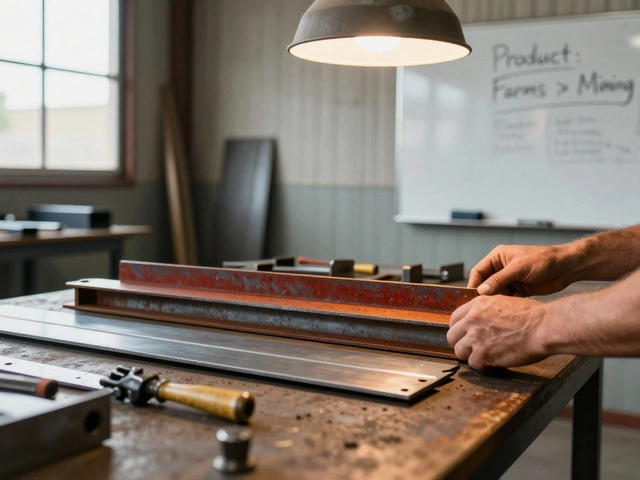How to Become a Successful Manufacturer: Step-by-Step Guide for 2025

Ever wonder why your favorite local brand seems to pop up everywhere, from tiny shops to big city billboards? More often than not, it started out with someone looking at a simple product and thinking, "Hey, I could make this." Becoming a manufacturer isn’t about owning a massive factory overnight or having a billionaire’s bank balance. It's about spotting a gap, being practical, and learning on the go. Now, if you’re reading this, I bet you've looked at something in your daily routine—maybe a kitchen gadget that could be better, a lack of local toys, or just annoyingly expensive imported stuff—and thought, "Someone should make that here." The great news? You might just be that someone. The manufacturing game in 2025 is where street smarts meet smart tech, old-school hustle mingles with online business tricks, and ordinary folks get to build products for thousands, sometimes millions.
Spotting Opportunities: What Should You Manufacture?
The first challenge you'll run into is figuring out what exactly to make. It’s not about copying every successful product out there—there’s already too much of that. Instead, ask yourself what’s missing in your city, region, or even country. Are there daily items people import but wish were more affordable? Are there frustrations with quality or design? Everyday products we take for granted—water bottles, office supplies, basic home goods—all began as someone’s idea for a better, cheaper, or local version.
Dig a little into local markets or scan trending online shops. Notice shortages, rising prices, or people constantly complaining about some item. That's your gold mine. For example, in 2024, the domestic toy manufacturing scene boomed in India after toy import restrictions, meaning new brands popped up everywhere. Another example—upcycled furniture made from old wood panels, which skyrocketed once eco-friendly trends took center stage. If you find a niche, like hardware supplies for boutique carpenters, or low-cost health foods, you’ve got a shot.
Still stuck? Go social: ask small business owners or daily shoppers what bugs them about stuff they have to buy from outside. Scroll through comment sections on marketplace sites for recurring complaints like "Breaks easily!" or "Too expensive!" Believe it or not, some of the best home-grown manufacturers began by scrolling, listening, and then acting. To put it simply, manufacturing opportunities are all around, but they’re hiding in supply gaps, rising prices, or customer frustrations.
Setting Up: The Real Cost and What You Need
Folks often picture manufacturing as needing super-high-tech machines, 24/7 power, or a crew of fifty right off the bat. But that’s just not true in most cases, especially with small or mid-level setups. Sure, if you’re thinking steel beams or car engines, you’ll need deep pockets. But loads of everyday manufacturing businesses started out in a garage, spare room, or rented workshop. The trick is to start small and level up as you go.
Let's talk numbers. Based on FICCI and Startup India data for 2024, entry into basic manufacturing (plastic items, food packing, textiles) can range from INR 2 lakh to INR 12 lakh. For something more complex like simple electronics assembly, you might look at INR 10–20 lakh initially—mainly for semi-automatic machines, basic tools, and rent. If you’re crafty and able to buy second-hand, your upfront costs drop even further. The biggest mistake? Overbuying equipment or renting a space way too huge for your needs. My buddy Raj made that mistake with a printing setup; he ended up using only a quarter of his huge warehouse for the first year while paying a fortune in rent.
Here’s what you truly need, no matter your product:
- Clear business plan (jot down your idea, rough costs, who will buy from you, where you’ll get raw material, and who’s making the stuff—are you doing it yourself or hiring?)
- Legal registration and licenses (look up Udyam Registration, GST if needed, pollution/noise clearances only if your product or processes require them)
- Raw materials or components (source them local—saves on import hassles and delays, plus buyers love a ‘locally made’ tag in 2025)
- Basic equipment and tools (don’t get lured by fancy automation - start low-cost, build as orders grow)
- Reliable workers or helpers if required (even family, friends, or skilled freelancers can help launch your early batches)
- Contacts with packaging suppliers, transporters, or small e-commerce partners
And yes, make sure you have a business bank account, not your personal one. Every rupee in or out should pass through this—it’s just easier for keeping track, claiming tax breaks, and keeping business and daily life separate (ask me, I learned this the hard way thanks to some messy accounting in my first year). And let’s get real—all the advice about "aiming for the stars" is good, but if Neha (my spouse) has taught me anything, it's this: focus on nailing your daily basics first.
| Type of Manufacturing | Typical Startup Cost (INR) | Most Needed Licenses | Fastest Growth Sector (2024–25) |
|---|---|---|---|
| Food Processing (Snacks, Packaged Foods) | 2-10 Lakh | FSSAI, Udyam, GST | Ready-to-Eat, Health Foods |
| Plastic Articles (Household, Packaging) | 3-9 Lakh | Pollution Control, Udyam, GST | Eco-friendly Packs |
| Textiles (Garments, Linens) | 4-12 Lakh | Udyam, GST | Printed T-shirts, Sustainable Fabrics |
| Electronics Assembly | 12-25 Lakh | BIS, Udyam, GST | LED Lighting, Small Gadgets |
| Furniture (Wood, Metal, Modular) | 7-17 Lakh | Udyam, GST | Modular, Upcycled |

Cracking the Production Process: From Raw Idea to Real Product
You’ve mapped out your product and set up your basics. Now, it’s time to actually make something people want to use. The production process might sound boring, but it’s really where the magic—well, hard work and a little cleverness—happens. Start by figuring out how your chosen product is made, one step at a time. If it’s a kitchen gadget, break it down: what raw materials are needed, can parts be bought off-shelf, what basic machines will help, and how many hands do you need to help put it together?
Don’t just copy random YouTube tutorials—find the ones with clear assembly lines, maybe some industry pros who share behind-the-scenes tricks. Sometimes, the best process advice comes from trade fair videos or actual workers who’ve been on the job ten years. If possible, visit a similar unit nearby—most owners are actually happy to chat, as long as you’re not a direct competitor in the same neighborhood!
If you want your product to sell, quality can’t be an afterthought. Simple tricks help: do a daily checklist of things like sharp edges, leaks, or loose parts. Standardize your process (even if it feels robotic at first), because small problems become big fast once more orders roll in. Did you know about 56% of product returns in small manufacturing businesses happen due to skipped last-minute checks? That’s a lot of money and goodwill down the drain.
Now, don’t obsess over getting everything perfect right out of the gate. The smart thing is tweaking your process after each batch—swap out a slow tool, change up worker shifts, or modify packaging if you notice damages in transport. Always look for feedback: a WhatsApp group with buyers, or even shopkeepers selling your product, can tell you what’s breaking, leaking, or needs improvement. And hey, document it! A simple spreadsheet or notebook where you jot down what worked (and what failed) is a lifesaver on busy weeks.
If you’re dealing with food or something people put on their skin, your checks and licenses need to be even tighter. Regular lab tests, batch-wise samples, FSSAI or equivalent certifications, and proper storage are musts. This isn’t red tape—it's what keeps you in business and out of trouble.
Scaling Up and Getting Your Product Out There
If you think people will flock to your door the minute your product is ready, think again! Even a killer product won’t sell itself—distribution is half the battle now. While you’re still tiny, use every network you can: friends, relatives, neighbors, local shops, bulk buyers (schools, canteens, offices), and local markets. Small orders at first are fine; collecting that first batch of customer feedback is gold.
Once you’ve proven some demand, that’s when to get creative with marketing. These days, every small manufacturer uses WhatsApp and Instagram. I know a guy who started selling homemade pickles in Jaipur using nothing but a WhatsApp broadcast and now exports to three countries—zero fancy agency, all word-of-mouth and personal trust. The trick? Collect reviews. Before-and-after photos, chat screenshots, and little video testimonials work like magic. Offer a few discounts to early customers or throw in a sampler pack to a big buyer—it’s cheaper than advertising and way more trustworthy.
Partnering with e-commerce platforms in 2025 is easier than ever for manufacturers. Platforms like Amazon India and Flipkart have dedicated onboarding for small manufacturers, sometimes with free training or onboarding support. Check out the State Government’s export promotion or cluster initiatives too—UP’s ODOP (One District, One Product) scheme pumped in fresh orders for local manufacturers simply because they registered with the local authority. Ready to deliver wider? Tie up with a courier partner or aggregator; rates are crazy competitive now and tracking for businesses is simple.
Scaling up doesn’t mean getting huge instantly. It means improving the things that work and dropping what doesn’t. If a product size sells three times faster, focus on that. If a color dies on the shelf, drop it. Keep up with your raw material suppliers—as you scale, you can push for better prices or even credit terms to ease cash flow. You don’t just want profits, you want systems that don’t collapse when one worker is out sick or a shipment is late. Many successful manufacturers in 2024–25 swear by digitizing inventory and payments; there are simple apps that don’t cost much but save headaches later.
Above all, stay curious. No matter how steady your process, new trends and government policies are always shaking up the game. Last year, the BIS certification rules changed for several basic appliances—overnight, units went from market darlings to stuck inventory. Stay connected to industry updates so you’re not caught off-guard. If you’re relentless, responsible, and just practical, manufacturing isn’t a daydream—it’s a career you can build.





